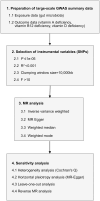Causal Links Between Gut Microbiota and Vitamin Deficiencies: Evidence from Mendelian Randomization Analysis
- PMID: 40192887
- PMCID: PMC12053135
- DOI: 10.1007/s11596-025-00038-y
Causal Links Between Gut Microbiota and Vitamin Deficiencies: Evidence from Mendelian Randomization Analysis
Abstract
Objective: Vitamin deficiencies, particularly in vitamins A, B12, and D, are prevalent across populations and contribute significantly to a range of health issues. While these deficiencies are well documented, the underlying etiology remains complex. Recent studies suggest a close link between the gut microbiota and the synthesis, absorption, and metabolism of these vitamins. However, the specific causal relationships between the gut microbiota composition and vitamin deficiencies remain poorly understood. Identifying key bacterial species and understanding their role in vitamin metabolism could provide critical insights for targeted interventions.
Methods: We conducted a two-sample Mendelian randomization (MR) study to assess the causal relationship between the gut microbiota and vitamin deficiencies (A, B12, D). The genome-wide association study data for vitamin deficiencies were sourced from the FinnGen biobank, and the gut microbiota data were from the MiBioGen consortium. MR analyses included inverse variance-weighted (IVW), MR‒Egger, weighted median, and weighted mode approaches. Sensitivity analyses and reverse causality assessments were performed to ensure robustness and validate the findings.
Results: After FDR adjustment, vitamin B12 deficiency was associated with the class Verrucomicrobiae, order Verrucomicrobiales, family Verrucomicrobiaceae, and genus Akkermansia. Vitamin A deficiency was associated with the phylum Firmicutes and the genera Fusicatenibacter and Ruminiclostridium 6. Additional associations for vitamin B12 deficiency included the Enterobacteriaceae and Rhodospirillaceae and the genera Coprococcus 2, Lactococcus, and Ruminococcaceae UCG002. Vitamin D deficiency was associated with the genera Allisonella, Eubacterium, and Tyzzerella 3. Lachnospiraceae and Lactococcus were common risk factors for both B12 and D deficiency. Sensitivity analyses confirmed the robustness of the findings against heterogeneity and horizontal pleiotropy, and reverse MR tests indicated no evidence of reverse causality.
Conclusions: Our findings reveal a possible causal relationship between specific gut microbiota characteristics and vitamin A, B12 and D deficiencies, providing a theoretical basis for addressing these nutritional deficiencies through the modulation of the gut microbiota in the future and laying the groundwork for related interventions.
Keywords: Causal relationship; Genome-wide association study; Gut microbiota; Mendelian randomization; Vitamin deficiencies.
© 2025. The Author(s).
Conflict of interest statement
Declarations. Conflict of Interest: The authors have no relevant affiliations or financial involvement with any organization or entity with a financial interest in or financial conflict with the subject matter or material discussed in this manuscript. This encompasses employment, consultancy, honoraria, stock ownership or options, expert testimony, grants, patents received or pending, or royalties. Human Ethics: In accordance with the prevailing legislation and institutional requirements, the study on human participants was exempt from the necessity of ethical review and approval. Furthermore, the design of this study does not necessitate the obtaining of written informed consent for participation, in accordance with the pertinent national legislation and institutional requirements. The individuals involved in this research did not provide written informed consent for the publication of any data or images that could be used to identify them. Ethical Approval and Consent to Participate: This study employed publicly accessible de-identified data from participant studies that had previously been approved by an ethical standards committee. Consequently, no further ethical approval was required for this study, and informed consent was waived. Consent for Publication: The work described has not been published before and is not under consideration for publication elsewhere. The publication has been approved by all co-authors.
Figures
References
-
- Trumbo P, Yates AA, Schlicker S, et al. Dietary reference intakes: vitamin A, vitamin K, arsenic, boron, chromium, copper, iodine, iron, manganese, molybdenum, nickel, silicon, vanadium, and zinc. J Am Diet Assoc. 2001;101(3):294–301. - PubMed
MeSH terms
Substances
LinkOut - more resources
Full Text Sources
Medical




